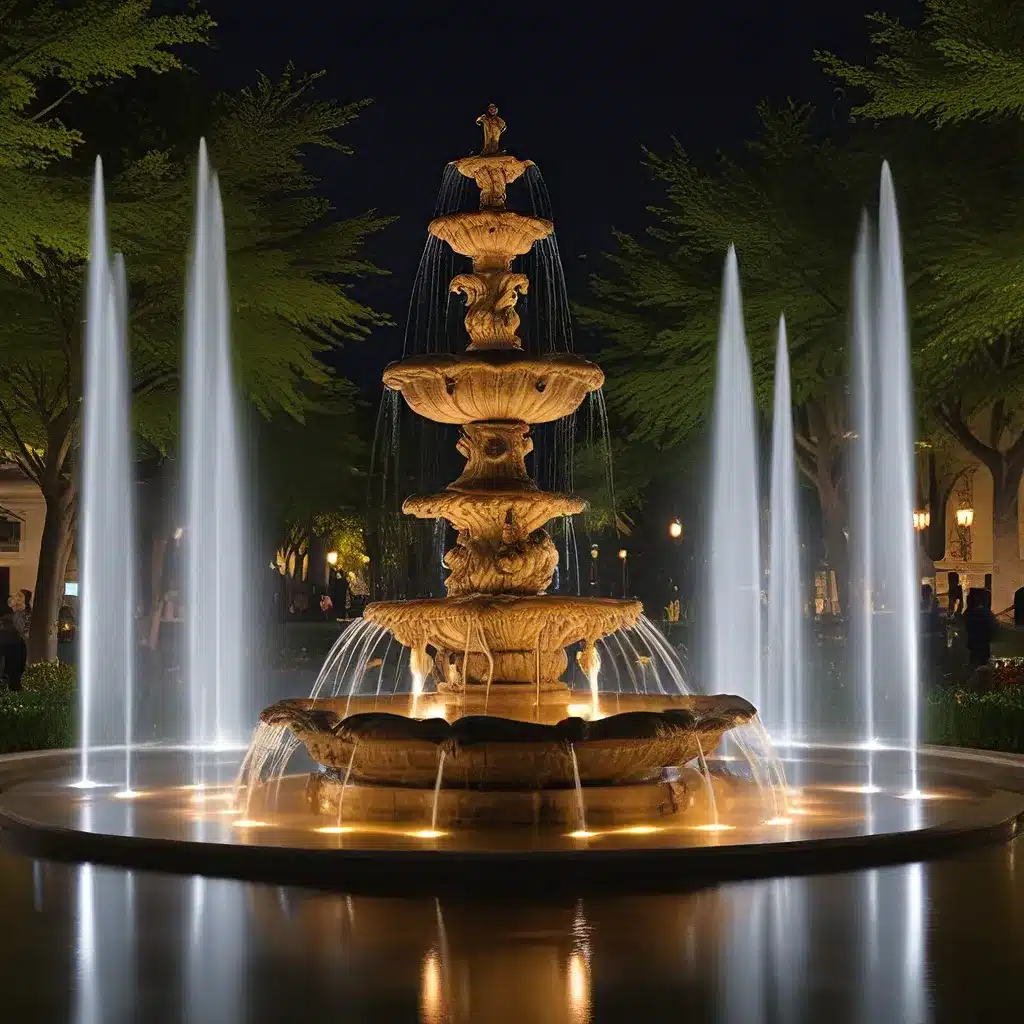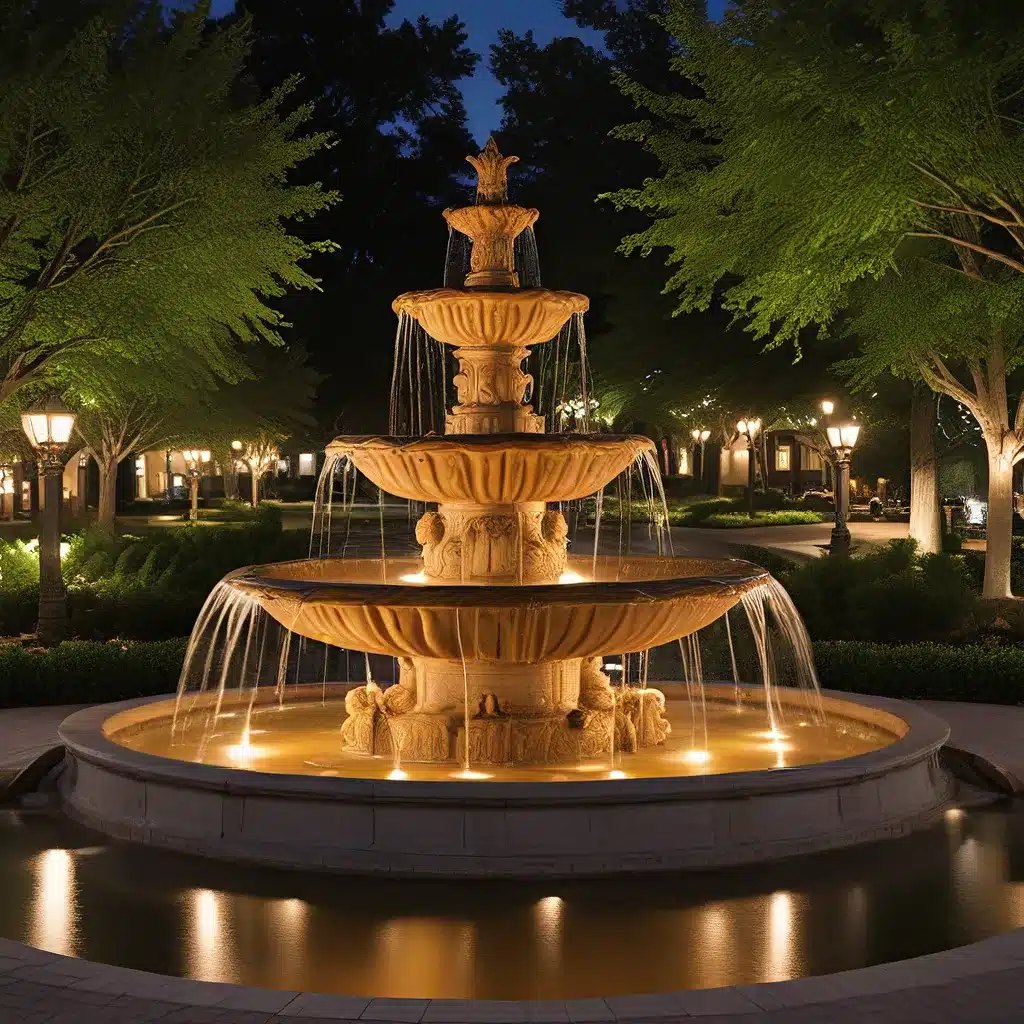
Fountain Design Essentials – Welcome to Fountain Lights
Fountain Design Essentials – Welcome to Fountain Lights

As someone who takes pride in crafting stunning water features, I’ve always been fascinated by the intricate dance between hydraulics and lighting design. It’s a captivating realm where the science of fluid dynamics meets the artistry of illumination, and the results can be truly mesmerizing.
Let me take you on a journey through this intersection, where the flow of water and the play of light come together to create magical experiences. Prepare to be immersed in a world where fountains don’t just quench our thirst for beauty, but also ignite our imagination.
It all starts with the water, doesn’t it? The hydraulic systems that power our fountains are the beating heart that bring them to life. These intricate networks of pipes, pumps, and nozzles are the unsung heroes, quietly orchestrating the fluid dynamics that captivate our senses.
Think of a fountain as a symphony, where each component plays a vital role in creating the grand performance. The pumps, for instance, are the conductors, controlling the tempo and volume of the water flow. The nozzles? They’re the musicians, responsible for shaping the water’s movement into mesmerizing patterns and arcs.
And let’s not forget the importance of pressure and flow rate – these are the keys that unlock the full potential of a fountain’s design. By carefully calibrating these variables, fountain designers can achieve everything from gentle, lapping waves to towering, powerful jets. It’s a delicate balance, like a tightrope walker navigating the currents of a raging river.
Now, let’s turn our attention to the captivating world of fountain lighting. This is where the science of hydraulics meets the magic of illumination, creating a synergetic dance that leaves onlookers spellbound.
Imagine a fountain at night, its waters shimmering with a kaleidoscope of colors, each hue carefully chosen to complement the fountain’s design. It’s a symphony of light and motion, a living, breathing work of art that can transform even the most mundane public space into a mesmerizing oasis.
But achieving this level of artistry requires a deep understanding of lighting principles and their interplay with water. Fountain designers must consider factors like color temperature, beam angles, and placement to ensure the lighting enhances the overall aesthetic, rather than detracting from it.
And let’s not forget the importance of energy efficiency and sustainability. Advancements in LED technology have revolutionized the fountain lighting industry, allowing designers to create breathtaking displays while minimizing their environmental impact. It’s a win-win for both the planet and the viewer.
The true magic happens when the worlds of hydraulics and lighting design collide, creating a synergetic fusion that captivates the senses. Imagine a fountain where the water’s motion is perfectly choreographed with the play of light, each element complementing the other to create a mesmerizing spectacle.
It’s a delicate balance, to be sure. Fountain designers must consider the interplay of water and light, adjusting variables like nozzle placement, water pressure, and lighting intensity to achieve the desired effect. It’s a bit like a dance, where each partner must anticipate the other’s movements to create a truly breathtaking performance.
And the results can be truly awe-inspiring. Imagine a fountain where the water seems to dance with the light, each arc and plume punctuated by a burst of color that leaves onlookers spellbound. It’s a sight that can transport us to a world of wonder, where the boundaries between science and art blur, and the only thing that matters is the sheer beauty of the moment.
Of course, the marriage of hydraulics and lighting design is not without its challenges. Navigating the technical complexities of these two disciplines requires a deep understanding of engineering principles, as well as a keen eye for aesthetic harmony.
One of the biggest hurdles fountain designers face is managing the flow of water to ensure it interacts with the lighting in the most visually captivating way. This often requires intricate calculations and simulations to predict the water’s movement and optimize the lighting accordingly.
And then there’s the issue of maintenance and reliability. Fountain systems are exposed to the elements, subject to weathering and wear over time. Designers must find ways to ensure their creations not only look stunning, but also function reliably for years to come.
But it’s in the face of these challenges that true innovation blossoms. Advancements in materials science, computational fluid dynamics, and smart lighting technologies have opened up new frontiers in fountain design, allowing designers to push the boundaries of what’s possible.
As I gaze into the crystal ball of fountain design, I see a future where the intersection of hydraulics and lighting becomes even more seamless and captivating. Imagine fountains that respond dynamically to our presence, adjusting their flow and illumination to create truly personalized experiences.
Computational fluid dynamics and real-time control systems may one day allow fountains to adapt to weather conditions, wind patterns, and even the mood of the surrounding environment. Smart lighting systems could coordinate with the water’s movement, creating a truly immersive and responsive display.
And who knows what other innovations are on the horizon? Perhaps we’ll see fountains that harness renewable energy sources, or even ones that double as water purification systems, bringing a new level of sustainability to the art form.
The possibilities are truly endless, limited only by the imagination and creativity of those who dare to push the boundaries of what’s possible. And as a passionate fountain enthusiast, I can’t wait to see what the future holds. After all, the dance between water and light is one that will continue to captivate and inspire us for generations to come.
Share to :
Subscribe to our newsletter for the latest in fountain design, innovative lighting ideas, and exclusive tips straight to your inbox. Join the community shaping the future of water features.

Rapid delivery to your doorstep.

Excellence in every product.

Great value for your investment.

Assistance at any hour.
Fountain Lights — Illuminating creativity in every splash!
Copyright © 2023. All Right Reserved